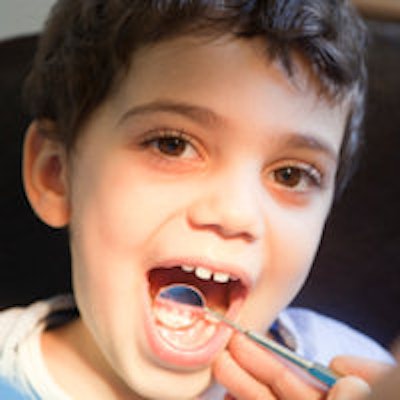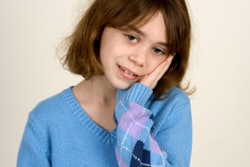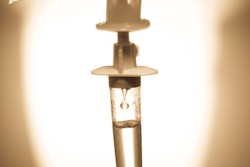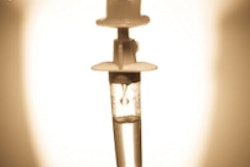
Pediatric oral sedation for dental treatment often results in excessive sleepiness, nausea, and vomiting after the child is discharged, according to a new study in Anesthesia Progress. The findings stress the importance of proper postoperative instructions to caregivers, including possible complications, and careful vigilance of the child.
"Pediatric patients often need and benefit from sedation in order for dental treatment to be atraumatic and completed safely," the study's lead author, Annie Huang, DMD, explained to DrBicuspid.com.
Studies and documented cases show that adverse events after sedation frequently involve the inability to arouse patients and/or patients having difficulty breathing, possibly because they are allowed to leave the office too soon. Therefore, the use of specific and objective discharge criteria, outlined in guidelines from the American Academy of Pediatric Dentistry (AAPD), is vital, the authors noted.
"The results suggest that prolonged sedative effects and other adverse events are relatively common following oral sedation," the group wrote.
“It is imperative for the dental practitioner to be cognizant of each patient's sedation level at all times.”
Possible complications
Although sedation is generally safe when practiced by qualified health practitioners on appropriately selected patients, serious adverse events during deep sedation may occur, including difficulty breathing, brain damage, and death. The authors noted, however, that serious adverse events can be minimized by the following actions:
- Proper monitoring of the patient
- Comprehensive training of the clinician and staff
- A suitable drug regimen
- Appropriate patient selection
- Adherence to discharge criteria
Variable levels of consciousness can be induced by a drug's sedative effects, which differ among patients, Dr. Huang said.
"Patient disposition and variable drug bioavailability are some factors that account for these differences [in patients' reactions]," she told DrBicuspid.com. "It is imperative for the dental practitioner to be cognizant of each patient's sedation level at all times. Furthermore, each patient may exhibit variable postdischarge effects, so the caregiver of the patient must be well-instructed to observe the patient vigilantly."
Dr. Huang is an assistant professor of clinical dentistry at the University of Southern California (USC) Herman Ostrow School of Dentistry.
Different anesthetics
The goal of the prospective study was to examine discharge criteria and the adverse events experienced after discharge in a group of children who received sedation at USC's Pediatric Dentistry Clinic, the authors wrote (Anesth Prog, Fall 2015, Vol. 62:3, pp. 91-99).
The 46 pediatric patients in the study received combinations of a narcotic (morphine or meperidine), sedative-hypnotic (chloral hydrate), benzodiazepine (midazolam or diazepam), or antihistamine (hydroxyzine HCl). The following dosages were used: 0.66 mg/kg for morphine, 2 mg/kg for meperidine, 0.5 to 0.7 mg/kg for midazolam, 0.5 to 0.7 mg/kg for diazepam, and 2 mg/kg for hydroxyzine HCl.
| Oral sedation drug regimens | |
| Regimen | No. of patients (%) |
| Morphine, midazolam, and hydroxyzine | 21/46 (45.6) |
| Morphine, diazepam, and hydroxyzine | 13/46 (28.3) |
| Chloral hydrate, meperidine, and hydroxyzine | 7/46 (15.2) |
| Morphine and hydroxyzine | 3/46 (6.5) |
| Meperidine, midazolam, and hydroxyzine | 1/46 (2.2) |
| Midazolam | 1/46 (2.2) |
The patients were also given local anesthesia (lidocaine) and nitrous oxide with oxygen. Informed consent for sedation and dental treatment was obtained.
The group consisted of 23 boys and 23 girls, ranging in age from 26 months to 10 years (mean, 5.8 years). More than 80% (37/46) of the children were Hispanic, with the other nine children divided between black, white, Asian, and unknown ethnicities.
"[More than] 75% of our subjects were given a drug regimen including morphine, and the majority of the sedation visits were deemed excellent, good, or fair by the resident doctor completing the dental treatment," Dr. Huang said. "These results [showed] that morphine sulfate may be a promising sedative for pediatric patients undergoing dental treatment with oral sedation."
Children's responses
Notably, a higher proportion of patients who took the medication willingly exhibited a more effective sedation visit, compared with those who needed the medication to be syringed into the mouth.
After the dental treatment was complete, the patients' sedation levels were recorded. No sedation was characterized by cooperation and typical responses, minimal sedation was characterized by anxiety, and moderate sedation was defined as a purposeful response to verbal commands with or without light tactile sensation. Deep sedation levels were characterized by a purposeful response after repeated verbal or painful stimulation. All of the children were able to be aroused.
| Sedation level after treatment completion | |
| Level | No. of patients (%) |
| No sedative effect | 6/46 (13.0) |
| Minimal sedation | 13/46 (28.3) |
| Moderate sedation | 26/46 (56.5) |
| Deep sedation | 13/46 (28.3) |
Regarding the effectiveness of sedation, 11 sedations (23.9%) were deemed ineffective, 17 (37.0%) were effective, and 17 (37.0%) were very effective. Only one patient (2.2%) was reported as overly sedated.
Overall, the researchers found that excessive somnolence and to a lesser extent nausea and vomiting were frequent postdischarge complications following oral sedation.
Excessive sleepiness was demonstrated in a majority of the children (65.2%), similar to the results of studies conducted with both oral sedation and general anesthesia. More than half of the children (56.5%) reached their normal baseline behavior within six hours following oral sedation and 15.2% of them took longer than 10 hours, according to caregivers.
| Postsedation symptoms | |
| Symptom | No. of patients (%) |
| Napped at home | 35/46 (76.1) |
| Napped more than usual | 30/46 (65.2) |
| Slept on the way home | 28/46 (60.1) |
| Nausea | 9/46 (19.6) |
| Vomiting (among those with nausea) | 5/9 (55.6) |
| Fever | 3/46 (7.0) |
| Altered cognitive function | 7/22 (31.2) |
Recovery time to baseline status ranged from a few hours to the following morning.
"Interestingly, some caretakers reported a significant recovery time to baseline up until the following morning after the dental visit," Dr. Huang said.
Overall, no major adverse effects associated with airway obstruction were reported during follow-up phone calls with caretakers. However, the researchers emphasized the need for thorough preoperative screening and special postoperative precautions for patients with respiratory diseases such as asthma or reactive airway disease.
The study strongly supports the importance of proper postoperative instructions to the patient's caregiver, including possible complications, and the need for careful vigilance of the child until recovery is complete, the group concluded.



















